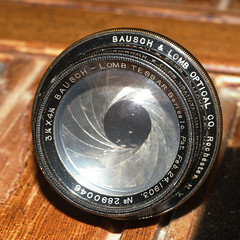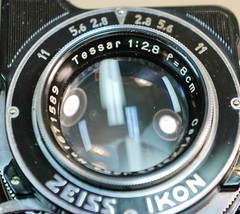Difference between revisions of "Tessar"
(+ refs to two patents 1902-3, and minor corrections to text.) |
(+ patents for the Unar and Anastigmat/Protar, and text citing them.) |
||
| Line 9: | Line 9: | ||
}}The '''Tessar''' is a camera and projection [[lens]] designed by [[Paul Rudolph]], working for the [[Carl Zeiss]] Jena company, in 1902. It is normally used as a standard lens, and versions of it have been fitted to many millions of cameras. | }}The '''Tessar''' is a camera and projection [[lens]] designed by [[Paul Rudolph]], working for the [[Carl Zeiss]] Jena company, in 1902. It is normally used as a standard lens, and versions of it have been fitted to many millions of cameras. | ||
| − | The design consists of four elements in three groups; the front element is positive, bi-convex (with the rear almost flat), the central a negative bi-concave and, following an aperture, at the rear is a cemented doublet of plano-concave and | + | The design consists of four glass elements in three groups; the front element is positive, bi-convex (with the rear almost flat), the central a negative bi-concave and, following an aperture, at the rear is a cemented doublet of one plano-concave and one bi-convex element. |
| + | |||
| + | The design is often described as a "modified [[Cooke triplet]]"; this is an easy way to explain the construction of the Tessar to a person familiar with a triplet lens. However, the design is actually a development of Rudolph's earlier lenses.<ref>Kingslake, Rudolph, ''A History of the Photographic Lens'', Academic Press, (1989). "It is certain that the [[Tessar]] was not a modified [[Cooke Triplet]], as the series of steps followed by Dr. Paul Rudolph in going from the [[Anastigmat]] to the Tessar are well established, but for some of the later designs it is not always clear whether they should be regarded as modified Tessars or modified Triplets." </ref> Rudolph's US Patent for the Tessar states that the design combines features from two earlier Zeiss lenses, one consisting of air-spaced groups facing each other, the other of two cemented groups (the forerunner of the Protar).<ref>[http://worldwide.espacenet.com/publicationDetails/originalDocument?CC=US&NR=721240A&KC=A&FT=D&ND=3&date=19030224&DB=worldwide.espacenet.com&locale=en_EP US Patent 721240], ''Photographic Objective'', filed July 1902 and granted February 1903 to Paul Rudolph and the Carl Zeiss company; describing an f/5.5 Tessar design; at [http://worldwide.espacenet.com/?locale=en_EP Espacenet], the patent search facility of the European Patent Office. The patent cites two earlier patents: [http://worldwide.espacenet.com/publicationDetails/originalDocument?CC=US&NR=444714A&KC=A&FT=D&ND=3&date=18910113&DB=worldwide.espacenet.com&locale=en_EP US Patent 444714], ''Photographic Objective'', filed April 1890 and granted January 1891 to Rudolph and the Carl Zeiss company, describing several lenses made up as two cemented groups of two or three glass elements (one of these designs was commercially produced as the Zeiss Anastigmat, and was developed to become the Protar); and [http://worldwide.espacenet.com/publicationDetails/originalDocument?CC=US&NR=660202A&KC=A&FT=D&ND=3&date=19001023&DB=worldwide.espacenet.com&locale=en_EP US Patent 660202], ''Photographic Objective'', filed January 1900 and granted October 1900 to Rudolph and the Carl Zeiss company, describing several designs using air-spaced glass elements (one of the diagrams includes a cemented pair). One of these designs, with four elements, was produced as the Unar; see Greenleaf (cited below), p70-1 and 82-4.</ref> | ||
<br style="clear:right"/> | <br style="clear:right"/> | ||
| Line 27: | Line 29: | ||
}} | }} | ||
| − | The first patented design is for an f/5.5 lens.<ref>[http://worldwide.espacenet.com/publicationDetails/originalDocument?CC=AT&NR=13124B&KC=B&FT=D&ND=3&date=19030825&DB=worldwide.espacenet.com&locale=en_EP Austrian Patent 13124], ''Sphärisch, chromatisch und astigmatisch korrigiertes Objektiv'' (spherically-, chromatically- and astigmatically-corrected lens), filed June 1902 and granted March 1903 to the Karl (''sic'') Zeiss company of Jena | + | The first patented design is for an f/5.5 lens.<ref>[http://worldwide.espacenet.com/publicationDetails/originalDocument?CC=AT&NR=13124B&KC=B&FT=D&ND=3&date=19030825&DB=worldwide.espacenet.com&locale=en_EP Austrian Patent 13124], ''Sphärisch, chromatisch und astigmatisch korrigiertes Objektiv'' (spherically-, chromatically- and astigmatically-corrected lens), filed June 1902 and granted March 1903 to the Karl (''sic'') Zeiss company of Jena, describing an f/5.5 Tessar design, at Espacenet; also US Patent 721240, cited above, which is the English-language equivalent. The database at Espacenet does not appear to have the German patent.</ref> This design was not made commercially, however; the first Tessars offered for sale were an f/6.3, and an f/10 apochromatic lens (that is, one corrected to give the same focus at ''three'' wavelengths);<ref>Greenleaf, Allen R. (1950) ''Photographic Optics'', Macmillan, New York, p77-82.</ref> developments in design allowed f/2.8 by 1930. |
In addition to production by [[Carl Zeiss]], the Tessar name and design (under license) was used in the production of numerous lenses by [[Bausch & Lomb]] (Rochester), [[Ross]] (London) and [[Krauss]] (Paris). | In addition to production by [[Carl Zeiss]], the Tessar name and design (under license) was used in the production of numerous lenses by [[Bausch & Lomb]] (Rochester), [[Ross]] (London) and [[Krauss]] (Paris). | ||
Revision as of 12:17, 19 August 2013

|
| original Tessar from Zeiss collection image by Uwe Kulick (Image rights) |
The Tessar is a camera and projection lens designed by Paul Rudolph, working for the Carl Zeiss Jena company, in 1902. It is normally used as a standard lens, and versions of it have been fitted to many millions of cameras.
The design consists of four glass elements in three groups; the front element is positive, bi-convex (with the rear almost flat), the central a negative bi-concave and, following an aperture, at the rear is a cemented doublet of one plano-concave and one bi-convex element.
The design is often described as a "modified Cooke triplet"; this is an easy way to explain the construction of the Tessar to a person familiar with a triplet lens. However, the design is actually a development of Rudolph's earlier lenses.[1] Rudolph's US Patent for the Tessar states that the design combines features from two earlier Zeiss lenses, one consisting of air-spaced groups facing each other, the other of two cemented groups (the forerunner of the Protar).[2]

|
| Cross-section of a 50mm f2.8 Tessar, with front element on the left. (for 35mm, M42 fitting) by AWCam (Image rights) |

|
| Cut-away diagram of a Tessar scanned by Uwe Kulick (Image rights) |
The first patented design is for an f/5.5 lens.[3] This design was not made commercially, however; the first Tessars offered for sale were an f/6.3, and an f/10 apochromatic lens (that is, one corrected to give the same focus at three wavelengths);[4] developments in design allowed f/2.8 by 1930.
In addition to production by Carl Zeiss, the Tessar name and design (under license) was used in the production of numerous lenses by Bausch & Lomb (Rochester), Ross (London) and Krauss (Paris).
The Tessar design has been widely copied by nearly all major optics companies. By 2002, Carl Zeiss, Inc. had produced over five million Tessar lenses, and they estimated the total number of Tessar formula lenses at more than 150 million.[5]
A very partial list includes:
- Agfa Solinar
- Asahi/Pentax Macro-Takumar 50mm f/4
- Bausch & Lomb Tessar (under license)
- Canon 50mm FL f/3.5, 38mm FLP, 50mm f/2.8 and f/3.5(RF), 35mm f/3.5(RF)
- Dallmeyer Dalmac, Perfac, Serrac
- Ernemann Ernon

|
| Tessar Series 1c Pat Feb 24, 1903 made by Bausch & Lomb image by Nesster (Image rights) |
- FED/KMZ Industar
- Ilex Paragon
- Kodak Ektar
- Konica Macro-Hexanon AR 55 mm f/3.5
- Krauss-Zeiss Tessar (under license)
- Leitz Elmar
- Mamiya Press lenses - 100mm f/3.5, 127mm f/4.7, 150mm f/5.6
- Meyer Primotar
- Minolta Rokkor TLR
- Minox Minoxar
- Nikon 45mm GN Nikkor, El-Nikkor 50mm f/4
- Olympus in many of their compact cameras including the Trip 35 (40mm f/2.8) and mju series.
- Plaubel Anticomar
- Rodenstock Ysar, Rogonar
- Ross Xtralux

|
| Tessar on Ikonta image by Mario Groleau (Image rights) |
- Ross Tessar (under license)
- Schneider Xenar, Comparon
- Taylor & Hobson Apotal, Ental
- Voigtlander Heliostigmat, Skopar
- Wollensak Raptar
- Yashica Yashinon TLR, Yashica T AF
- Zeiss Tessar
Notes
- ↑ Kingslake, Rudolph, A History of the Photographic Lens, Academic Press, (1989). "It is certain that the Tessar was not a modified Cooke Triplet, as the series of steps followed by Dr. Paul Rudolph in going from the Anastigmat to the Tessar are well established, but for some of the later designs it is not always clear whether they should be regarded as modified Tessars or modified Triplets."
- ↑ US Patent 721240, Photographic Objective, filed July 1902 and granted February 1903 to Paul Rudolph and the Carl Zeiss company; describing an f/5.5 Tessar design; at Espacenet, the patent search facility of the European Patent Office. The patent cites two earlier patents: US Patent 444714, Photographic Objective, filed April 1890 and granted January 1891 to Rudolph and the Carl Zeiss company, describing several lenses made up as two cemented groups of two or three glass elements (one of these designs was commercially produced as the Zeiss Anastigmat, and was developed to become the Protar); and US Patent 660202, Photographic Objective, filed January 1900 and granted October 1900 to Rudolph and the Carl Zeiss company, describing several designs using air-spaced glass elements (one of the diagrams includes a cemented pair). One of these designs, with four elements, was produced as the Unar; see Greenleaf (cited below), p70-1 and 82-4.
- ↑ Austrian Patent 13124, Sphärisch, chromatisch und astigmatisch korrigiertes Objektiv (spherically-, chromatically- and astigmatically-corrected lens), filed June 1902 and granted March 1903 to the Karl (sic) Zeiss company of Jena, describing an f/5.5 Tessar design, at Espacenet; also US Patent 721240, cited above, which is the English-language equivalent. The database at Espacenet does not appear to have the German patent.
- ↑ Greenleaf, Allen R. (1950) Photographic Optics, Macmillan, New York, p77-82.
- ↑ Innovation – The Magazine from Carl Zeiss", Issue 11, Carl Zeiss, Inc.